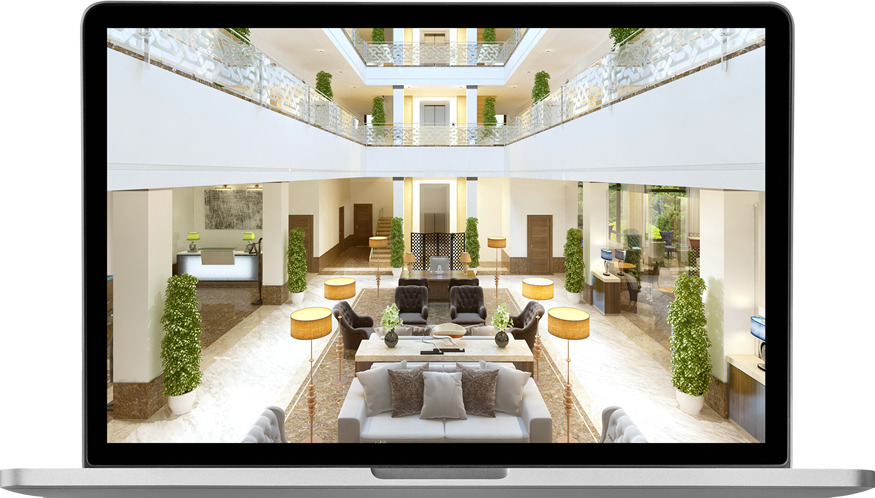Long gone are the days when internet users had little to no choice but to tolerate the frozen screens and slow loading browsers as consequences of triggering pop-up spam online. The old online pop-up could best compared to a physical flyer or postcard luring you into a store at the mall with some type of deal or offer.
…Now imagine getting handed a new brochure for every ten steps taken once in a store or booth at the mall. If you are short on patience or feel that this is a waste of trees/space in the recycling bin, the more flyers you receive, the less likely you are to buy (especially if the offer/deal is weak or non-existent). A single flyer with a great deal is a valued gift, multiple flyers with no value are just garbage and pop-ups are no different. For this reason, there is no better time but now to adopt and discover the benefits of the repurposed, Pop-Up 2.0 — a new take on the dated and deemed ineffective, digital marketing tool.
The New Pop-Up, also known as a Targeted Marketing Message, is designed to improve conversions on your site by encouraging visitors to book direct, highlighting flash sales, promoting need dates, and encouraging online engagement with your hotel. The key to implementing this marketing tool reborn is understanding that successful pop-ups avoid annoying visitors at all cost. Successful pop-ups are well-designed and thoughtfully executed, with compelling content, and appear on a page with information that is relevant.
The Proof is in the Pop-Up
While historically abused and earning rap as pesky, internet pollutant, the pop-up concept, in light of modernized marketing efforts, is getting its redemption. Such interactive targeted marketing messages have the ability to increase conversions by up to 1,300 percent and reduce bounce rates by 69 to 40 percent -data that clearly shows website visitors as having meaningful interactions with pop-ups.
Website pop-ups, or site overlays, are still a highly contested subject today, despite proven useful in certain situations. With the average website seeing 98% of visitor traffic bounce, there are few reasons not to use a pop-up, such as a targeted message intended for exit prevention.
Still consider yourself a skeptic? Think of it like this: What ratio of that 98% plan on visiting your site a second time?
A Time and Place for Targeted Marketing
When used responsibly, interactive pop-up engagements tactically target site visitors with a healthy level of intent to book or buy. This type of targeted marketing can also be used as a tool to create opportunities for eCommerce upsell, such as package add-ons and amenity upgrades through direct booking. Pop-up demand ultimately stems from trackable website performance trends, such as landing page bounce rate, abandonment, and check rate. Think of pop-ups as a solution to a specific problem. While there is no clear-cut, single fixed pop-up format, there are many targeted marketing message solutions designed to meet the unique demands of the following potential use cases:
Book Direct Messaging
For hotel brands relying on direct bookings to avoid losing revenue to competitors or OTAs, investing in targeted website marketing and booking-engine strategies is vital. It is crucial to quickly captivate visitors in the research and booking stages of travel using unique call-to-actions (CTAs) or interactive display messaging.
“Book direct to receive the best available rate!”
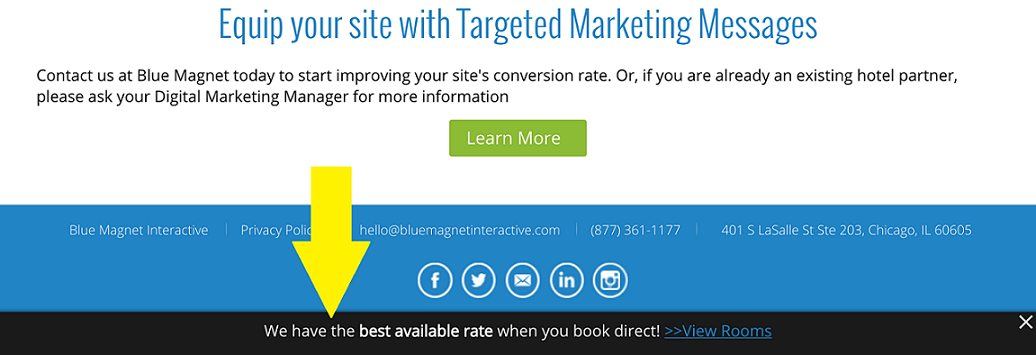
Pro tip: Alert potential guests of the advantage in booking directly through your website by including a ‘book direct for the lowest price guaranteed’ note at the bottom of any high-traffic page.
Need Date Targeting
One of the easiest ways to drive increased eCommerce sales month-over-month is by strategically building new pop-ups to launch on your site. Target the hotel’s need dates by giving your visitors a reason to book.
“Visit Washington, DC this winter and save 25%!”
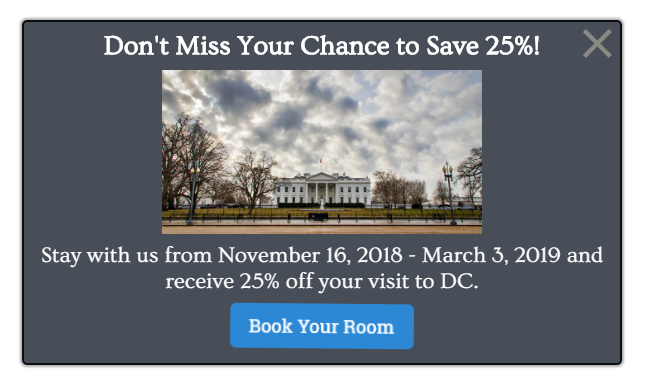
Pro tip: This type of marketing message works best when combined with a special promotion or reservation incentive and can be used to trigger on traditionally slow booking days.
Site Exit/Abandonment Prevention
In 2017, the travel industry saw a reported 82% of shopping-cart abandonment among booking engines. Giving the potential guest a last chance to make a reservation or present an offer when they attempt to jump ship will ultimately help increase opportunities for conversion.
“Reserve a table before you go!”
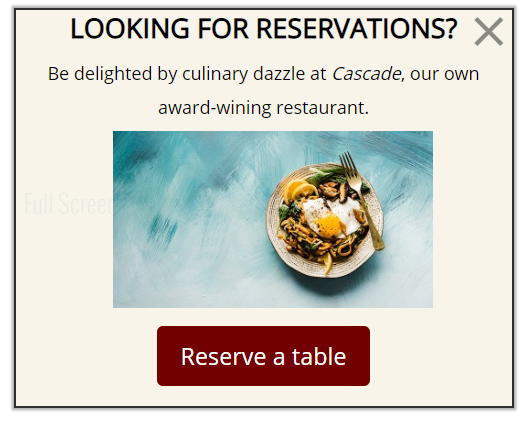
Pro tip: Use clear call-to-actions or exit offers from the reservation shopping cart to directly target those visitors who are slipping out of the conversion funnel.
Amenity/Special Feature Prompt
Include a note to inform or remind potential guests about some of the highest converting property features and/or promotions taking place at the hotel.
“In search of a dog fur-iendly hotel? Explore our pet accommodations!”
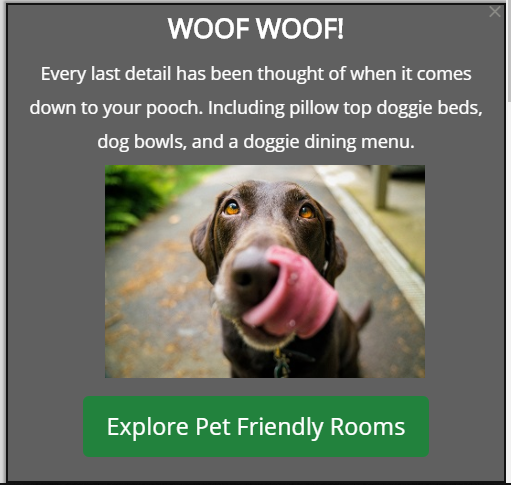
Pro tip: Use small, non-invasive displays, such as a pet-themed pop-up that features your pet-friendly amenities, to showcase critical offers and incentives.
Other Potential Use Cases:
- Email/Social Signups
- Flash Sales
- Dining/Tour Reservations
- Feature or Special Promotion
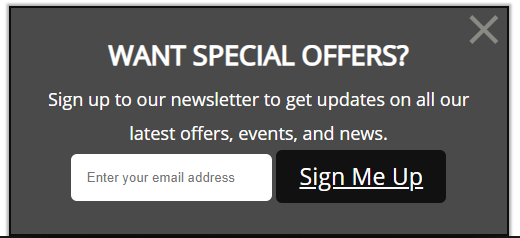
Which Targeted Marketing Message Meets Your Needs?
On YOY average, a significant source of revenue loss for your hotel/business is…
- OTAs/third party booking commission fees.
- Increased vacancy during the off-season or slow periods.
- Above average bounce rates in the booking widget/shopping cart.
- Competitors/rival hotels or businesses nearby.
Which attribute do you find appeals most to the majority of your guests/customers?
- Standard Rates
- Seasonal Accommodation
- Specials/Promotions
- Unique Amenities
Which (trackable) behavior of website visitors are you most interested in targeting?
- Number of page views per session.
- Visits during certain days of the week/times of the day.
- Duration on a specific page/set of pages.
- Entrance source (search engine, domain)/medium (organic, PPC, referral).
Answer Key
1. Book Direct Messaging — a message targeting guests who are browsing the Rooms page or booking widget can be used to present an offer or benefit for booking directly on your site.
2. Need Date Targeting — a targeted marketing message focused on increasing foot traffic and reservations during a time of need- either a known slow period or a time of seasonal uncertainty, might be just the ticket for saving your hotel from drastic revenue loss.
3. Site Exit/Abandonment Prevention — a pop-up to prevent site visitors from leaving before they have made it to the final stages of the booking/travel funnel is a way to help save what would otherwise be a lost sale and turn it into a potential reservation.
4. Amenity/Special Feature Prompt — a campaign to promote your hotel’s unique amenities and rare features can be used as a way to draw potential guests to your property/business over that of your competition.
Dress for Success
The key to target marketing message success is producing pop-ups that are “dressed to impress.” What exactly do I mean by this? Individual elements of a campaign’s overall design each play a role in creating audience appeal and influencing overall user experience. There are several steps you can follow to ensure that you are building different pop-ups for your hotel that not only look good but are also designed to achieve the results.
Impressive Pop-Up Design Checklist:
- Use compelling imagery that illustrates the value in the message you are trying to get across to website visitors.
- Use relevant logos, branding colors, and font styles to make your campaign fit with the look and feel of your website.
- Create the conversion-driven copy to help get the right message across to everyone who interacts with your campaign.
- Optimize the layout and timing of your pop-up for mobile/tablet and desktop devices.
- Test the size and position of your pop-up to determine which placement gets the most engagement from your visitors.
Final Takeaway
Compel your website visitors to book direct, take advantage of special incentives or hotel deals, and ultimately consider the benefits of making a reservation with you over the competition. With targeted marketing messages (pop-ups) or strategically placed calls-to-action (CTAs), keep people on your site and incentivize them to ultimately make a purchase or secure a reservation.
When implementing these types of campaigns, it is important to note that a website with a pleasant pop-up converts better than one with a poorly designed or overbearing pop-up. All messages should be personalized to specific hotel offers, amenities, notes and more, and should be based on your analytical data concerning traveler type, the reason for visit, etc. Advanced user and booking rules also allow you to personalize pop-ups based on customer segmentation. Most, if not, all types of target marketing message campaigns can be fully customized to your liking.
Blue Magnet’s Targeted Marketing Messaging system can selectively target the website visitors that fit the goals of your hotel campaign. Contact us at Blue Magnet today to explore the benefits of Pop-Up 2.0 and start improving your site’s conversion rate. *If you are already an existing hotel partner, please reach out to your Digital Marketing Manager for more information.




